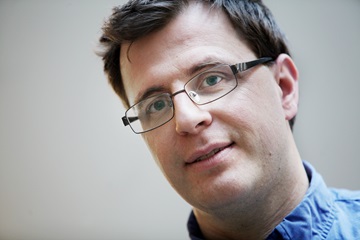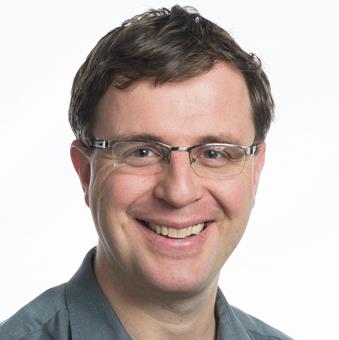Traditional plastics, or polymers, are electrical insulators. In the seventies a new class of polymers that conduct electricity like semiconductors and metals was discovered by Alan J.Heeger, Alan G. MacDiarmid and Hideki Shirakawa. This was the motivation for their Nobel Prize in Chemistry year 2000. Now Xavier Crispin, Docent in organic electronics at Linköping University’s Department of Science and Technology, has led a project where no fewer than twenty researchers from five universities worldwide have collaborated to prove that polymers can also be semimetals.
The results are published in an article in the prestigious journal Nature Materials, with Dr Crispin as principal author.
A few years ago Xavier Crispin discovered that conductive polymers can be thermoelectric. A thermoelectric material undergoes a diffusion of electronic charge carriers to the cold region when the material is submitted to a temperature gradient. As a result an electric potential is created between the cold and hot side of the material. This thermo-voltage is the basis of thermo-couples used for instance in an everyday oven thermometer.
“Our experiments yielded a high thermoelectric effect, a Seebeck effect, which indicated that we were dealing with semimetals. But we needed proof,” says Dr Crispin.
This required talented people from various locations to gain an in-depth understanding of the phenomenon. Foto: Ida Ling FlanaganNo less than twenty researchers from Sweden, Australia, Belgium, Norway and Denmark are co-authors of the article in Nature Materials. Ten of them are from Linköping University, including Xavier Crispin, Professor Magnus Berggren and Igor Zozoulenko from the Laboratory of Organic Electronics, Department of Science and Technology, Campus Norrköping, as well as Professor Mats Fahlman, Division of Surface Physics and Chemistry, and Professor Weimin Chen, Division of Functional Electronic Materials, both at the Department of Physics, Chemistry and Biology.
Foto: Ida Ling FlanaganNo less than twenty researchers from Sweden, Australia, Belgium, Norway and Denmark are co-authors of the article in Nature Materials. Ten of them are from Linköping University, including Xavier Crispin, Professor Magnus Berggren and Igor Zozoulenko from the Laboratory of Organic Electronics, Department of Science and Technology, Campus Norrköping, as well as Professor Mats Fahlman, Division of Surface Physics and Chemistry, and Professor Weimin Chen, Division of Functional Electronic Materials, both at the Department of Physics, Chemistry and Biology.
“It has been very impressive to see how Xavier Crispin has led this. We have a fantastic environment for materials research at Linköping University, with world-leading expertise. We are all friends and we’ve been able to produce this article without joint funding,” says Magnus Berggren, professor or organic electronics.
The theoretical input of Igor Zozoulenko, advanced spectroscopic analysis by Mats Fahlman and Weimin Chen at Linköping University, as well as state-of-the-art polymer samples and morphology studies by research colleagues in Australia, Belgium, Norway and Denmark showed the exact same thing: the polymer, in this case a doped variant of the plastic PEDOT, behaves exactly like a semimetal, which also explains the high Seebeck effect.
“These polymers are both easy and inexpensive to produce. That we now have an understanding of these phenomena will really drive developments forward, and will open up a new research field in organic electronics,” says Prof Berggren.
The research was financed primarily by ERC, the European Research Council. In 2012 Dr Crispin was awarded an ERC Starting Grant of SEK 13 million.
Semi-metallic polymers, Nature Materials
Olga Bubnova, Zia Ullah Khan, HuiWang, Igor Zozoulenko, Magnus Berggren and Xavier Crispin, Department of Science and Technology, Linköping University, Sweden.
Slawomir Braun, Daniel Dagnelund, Weimin M. Chen and Mats Fahlman, Department of Physics, Chemistry and Biology, Linköping University, Sweden.
Drew R. Evans, Manrico Fabretto, Pejman Hojati-Talemi, Peter J. Murphy, University of South Australia, Mawson Lakes, Australia.
Jean-Baptiste Arlin, Yves Geerts, Free University of Brussels, Bryssel, Belgium.
Simon Desbief, Roberto Lazzaroni, University of Mons, Mons, Belgium.
Dag W Breiby, Norwegian University of Science and Technology, Trondheim, Norway.
Jens W Andreasen, Technical University of Denmark, Roskilde, Denmark.
Nature Materials 2013-12-08
www.nature.com/naturematerials
2013-12-09
The results are published in an article in the prestigious journal Nature Materials, with Dr Crispin as principal author.
A few years ago Xavier Crispin discovered that conductive polymers can be thermoelectric. A thermoelectric material undergoes a diffusion of electronic charge carriers to the cold region when the material is submitted to a temperature gradient. As a result an electric potential is created between the cold and hot side of the material. This thermo-voltage is the basis of thermo-couples used for instance in an everyday oven thermometer.
“Our experiments yielded a high thermoelectric effect, a Seebeck effect, which indicated that we were dealing with semimetals. But we needed proof,” says Dr Crispin.
This required talented people from various locations to gain an in-depth understanding of the phenomenon.
Together they solved the mystery
 Foto: Ida Ling FlanaganNo less than twenty researchers from Sweden, Australia, Belgium, Norway and Denmark are co-authors of the article in Nature Materials. Ten of them are from Linköping University, including Xavier Crispin, Professor Magnus Berggren and Igor Zozoulenko from the Laboratory of Organic Electronics, Department of Science and Technology, Campus Norrköping, as well as Professor Mats Fahlman, Division of Surface Physics and Chemistry, and Professor Weimin Chen, Division of Functional Electronic Materials, both at the Department of Physics, Chemistry and Biology.
Foto: Ida Ling FlanaganNo less than twenty researchers from Sweden, Australia, Belgium, Norway and Denmark are co-authors of the article in Nature Materials. Ten of them are from Linköping University, including Xavier Crispin, Professor Magnus Berggren and Igor Zozoulenko from the Laboratory of Organic Electronics, Department of Science and Technology, Campus Norrköping, as well as Professor Mats Fahlman, Division of Surface Physics and Chemistry, and Professor Weimin Chen, Division of Functional Electronic Materials, both at the Department of Physics, Chemistry and Biology.“It has been very impressive to see how Xavier Crispin has led this. We have a fantastic environment for materials research at Linköping University, with world-leading expertise. We are all friends and we’ve been able to produce this article without joint funding,” says Magnus Berggren, professor or organic electronics.
The theoretical input of Igor Zozoulenko, advanced spectroscopic analysis by Mats Fahlman and Weimin Chen at Linköping University, as well as state-of-the-art polymer samples and morphology studies by research colleagues in Australia, Belgium, Norway and Denmark showed the exact same thing: the polymer, in this case a doped variant of the plastic PEDOT, behaves exactly like a semimetal, which also explains the high Seebeck effect.
Expensive alloys
Thermoelectric generators are available on the market today, but these are made from alloys of bismuth and the semimetal tellurium. Unlike the polymers, these elements are both rare and expensive.“These polymers are both easy and inexpensive to produce. That we now have an understanding of these phenomena will really drive developments forward, and will open up a new research field in organic electronics,” says Prof Berggren.
The research was financed primarily by ERC, the European Research Council. In 2012 Dr Crispin was awarded an ERC Starting Grant of SEK 13 million.
Semi-metallic polymers, Nature Materials
Olga Bubnova, Zia Ullah Khan, HuiWang, Igor Zozoulenko, Magnus Berggren and Xavier Crispin, Department of Science and Technology, Linköping University, Sweden.
Slawomir Braun, Daniel Dagnelund, Weimin M. Chen and Mats Fahlman, Department of Physics, Chemistry and Biology, Linköping University, Sweden.
Drew R. Evans, Manrico Fabretto, Pejman Hojati-Talemi, Peter J. Murphy, University of South Australia, Mawson Lakes, Australia.
Jean-Baptiste Arlin, Yves Geerts, Free University of Brussels, Bryssel, Belgium.
Simon Desbief, Roberto Lazzaroni, University of Mons, Mons, Belgium.
Dag W Breiby, Norwegian University of Science and Technology, Trondheim, Norway.
Jens W Andreasen, Technical University of Denmark, Roskilde, Denmark.
Nature Materials 2013-12-08
www.nature.com/naturematerials
2013-12-09
